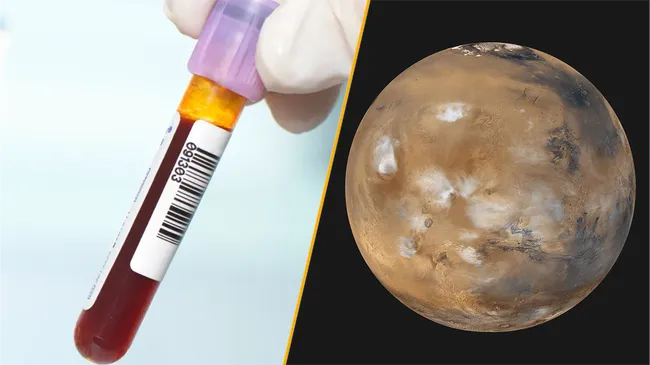Researchers have identified a never-before-seen human blood type in Guadeloupe, challenging current transfusion protocols, while Mars scientists uncover unusual spider-like surface patterns, adding mystery to the Red Planet’s geology.
Researchers have identified a never-before-seen human blood type in Guadeloupe, challenging current transfusion protocols, while Mars scientists uncover unusual spider-like surface patterns, adding mystery to the Red Planet’s geology.
In one of the most remarkable medical findings of 2025, researchers have discovered a completely new human blood type, never seen before in medical records or blood banks. The individual carrying this rare type is a woman in her sixties from Guadeloupe, currently residing in France. Doctors have now named her blood group \Gwada Negative\ in reference to her homeland and the antigen markers that set it apart from every known classification.
The discovery came during pre-surgical screening, where doctors noticed that her red blood cells did not match any of the 47 recognized human blood types. Further analysis revealed that her blood lacked key antigens necessary for compatibility with even the most rare donor groups. Eventually, genetic sequencing confirmed that a unique mutation in her PIGZ gene was responsible. This mutation alters how certain proteins are anchored to red blood cells, essentially creating a type so rare that she can only receive her own stored blood in case of emergency.
What makes this story even more profound is that her parents carried the gene, indicating a genetically inherited trait that may exist silently in others from similar backgrounds. Her case is a wake-up call to scientists around the world, emphasizing the importance of inclusive genomic studies and the possibility that more undiscovered blood types may exist, especially in underrepresented populations.
The implications for transfusion medicine are enormous. Blood banks around the world now face a new level of complexity: what happens when a patient has a blood group that simply doesn’t fit into any known system? This discovery also underscores the urgency of diversifying genetic databases, not just for rare disease treatment, but for life-saving transfusion planning as well.
Meanwhile, millions of miles away on the Red Planet, NASA’s Curiosity rover has made one of the most visually stunning discoveries in recent years. While navigating a section of Mount Sharp, the rover captured high-resolution images of unusual formations on the Martian surface that resemble sprawling spiderwebs etched into stone. Scientists have identified these formations as boxwork ridges, a geological structure formed through an ancient process of mineral deposition.
These Martian “spiderwebs” formed when groundwater once flowed beneath the planet’s surface, carrying minerals that filled cracks in the rock. Over millions of years, the surrounding softer material eroded away, leaving behind a rigid framework of harder mineral veins. The resulting network of ridges forms patterns that eerily mimic webs or cracked skin across vast stretches of terrain.
More importantly, these formations are not just beautiful—they are evidence of past water activity. Their presence proves that liquid water once moved through underground layers of Mars, providing yet another piece of the puzzle in the ongoing search for signs of ancient life. Since water is essential to life as we know it, discoveries like these bring renewed hope that Mars was once habitable, or at the very least, home to microbial organisms.
Curiosity is now drilling into and analyzing samples from these boxwork ridges. The goal is to determine the exact mineral composition, looking for potential organic molecules or biosignatures that could confirm ancient life processes. These efforts align with larger exploration goals shared by Perseverance and future Mars missions, all designed to answer the age-old question: Was Mars ever alive?
At first glance, the discovery of a new blood type and the unveiling of mineral ridges on Mars may seem unrelated. But both represent the cutting edge of modern science—exploring the outermost frontiers of what we know about life, whether on Earth or elsewhere.
In the case of the new blood type, science shows us that even now, the human body holds secrets we’ve never encountered before. Despite centuries of medical study, a single patient has shattered the assumption that our current classification systems are complete. In doing so, she’s opened new doors in transfusion science and genetics.
On Mars, boxwork ridges tell a similar story. They whisper of an alien world where water once moved through stone, carving pathways that could have sheltered life. They provide both a map of geological history and a potential guide for where to look next in the cosmic search for biology beyond Earth.
Both discoveries carry the same message: science is far from finished. There are still undiscovered systems, unseen structures, and untold stories waiting for exploration.
These two stories are deeply significant not just for scientists, but for everyday people.
The new blood type shows us the importance of diversity in scientific research. Until recently, most genetic research focused on populations from North America and Europe. But as we include more regions and ethnic groups, we uncover the true variability of humanity—and that can save lives.
The Martian spiderwebs remind us that planetary exploration is not about distant science fiction—it's about understanding how planets form, evolve, and maybe even harbor life. Every new pattern in Martian stone is a clue. Every sample drilled into Martian soil is a step closer to answering our biggest existential questions.
Highlighting these discoveries in your guest post can provide educational value and inspiration. Here are a few key ideas to emphasize:
🧬 Medical Education: Use the blood type story to discuss how personalized medicine depends on understanding rare genetic traits, and why blood banks must evolve their systems.
🪐 Space Enthusiasm: Share how Curiosity’s work on Mars demonstrates that we are still only scratching the surface of what Mars has to reveal.
🧠 Scientific Curiosity: These stories show that curiosity pays off—both on a planetary scale and at the level of individual patient care.
🧭 Human Perspective: Science isn’t just data. It’s stories—of real people, alien landscapes, and our never-ending quest to understand both ourselves and the universe.
For the woman with the newly discovered blood type, researchers are now searching for other individuals who may carry similar traits. There’s a possibility that isolated or genetically distinct populations may carry similar mutations. Genetic screening in these areas could help locate compatible donors and further expand our knowledge of rare blood types.
On Mars, Curiosity will continue its exploration of Mount Sharp, gathering more samples from the boxwork ridges. Scientists are planning to cross-analyze the samples with data from the Perseverance rover. Together, these machines form a tag-team of planetary exploration, helping us uncover the deep history of water, rock, and possibly life.
As we look ahead, science continues to expand the limits of the known world, one patient and one planet at a time.
This week’s science stories remind us that the universe is full of hidden marvels, whether buried deep in our DNA or etched into the rock of distant planets. A new blood type defies expectations. Strange spiderwebs carved by Martian water speak of planetary evolution and potential life. Both stories stretch the limits of what we thought we knew.
For writers, educators, and curious minds, these discoveries offer a golden opportunity to spark interest, deepen understanding, and share the joy of real-world science that still has surprises left to give.
Stay curious. Stay grounded. And always look deeper.
Like
Dislike
Love
Angry
Sad
Funny
Wow
California Bar Introduces Privacy Law Specialization to Meet Digital Era Demands
June 22, 2025Collagen Supplements Boom: Do They Really Improve Skin and Hair Health?
March 15, 2025Twitter Rolls Out New Feature Allowing Users to Tip Influencers Directly
April 08, 2025







Comments 0